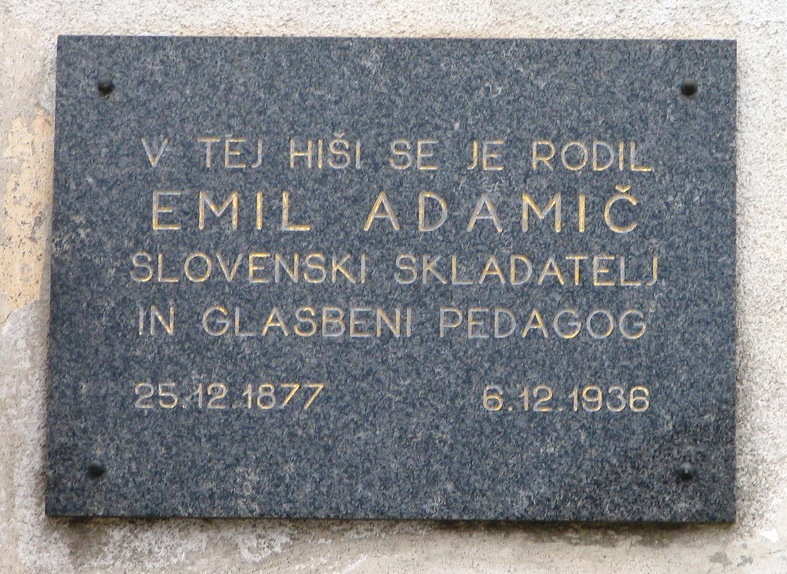Emil Adamič on:
[Wikipedia]
[Google]
[Amazon]
Emil Adamič (December 25, 1877 – December 6, 1936) was among the most productive Slovenian "Adamič, Emil." ''Primorski slovenski biografski leksikon.''
His works include the orchestral pieces ''Tatarska suita'' (Tatar Suite, 1918) and ''Ljubljanski akvareli'' (Ljubljana Watercolours, 1925) and the choral compositions ''Vragova nevesta'' (The Devil's Bride, 1925) and ''Smrt carja Samuela'' (The Death of Tsar Samuel, 1934). He also wrote songs that used elements of Slovenian folk music, such as ''Zimska kmečka pesem'' (A Farmer's Winter Song, 1903). His influences included
composer
A composer is a person who writes music. The term is especially used to indicate composers of Western classical music, or those who are composers by occupation. Many composers are, or were, also skilled performers of music.
Etymology and Defi ...
s. He wrote choral
A choir ( ; also known as a chorale or chorus) is a musical ensemble of singers. Choral music, in turn, is the music written specifically for such an ensemble to perform. Choirs may perform music from the classical music repertoire, which ...
and orchestral music
An orchestra (; ) is a large instrumental ensemble typical of classical music, which combines instruments from different families.
There are typically four main sections of instruments:
* bowed string instruments, such as the violin, viola, ce ...
, altogether over 1,000 works.
Adamič was born in Dobrova to August Adamič (1843–1915) and Katharina Brus Adamič (1854–1915). He studied at conservatories in Trieste
Trieste ( , ; sl, Trst ; german: Triest ) is a city and seaport in northeastern Italy. It is the capital city, and largest city, of the autonomous region of Friuli Venezia Giulia, one of two autonomous regions which are not subdivided into provi ...
and Ljubljana
Ljubljana (also known by other historical names) is the capital and largest city of Slovenia. It is the country's cultural, educational, economic, political and administrative center.
During antiquity, a Roman city called Emona stood in the ar ...
. During the First World War, he was a prisoner of war in Tashkent
Tashkent (, uz, Toshkent, Тошкент/, ) (from russian: Ташкент), or Toshkent (; ), also historically known as Chach is the capital and largest city of Uzbekistan. It is the most populous city in Central Asia, with a population of ...
.His works include the orchestral pieces ''Tatarska suita'' (Tatar Suite, 1918) and ''Ljubljanski akvareli'' (Ljubljana Watercolours, 1925) and the choral compositions ''Vragova nevesta'' (The Devil's Bride, 1925) and ''Smrt carja Samuela'' (The Death of Tsar Samuel, 1934). He also wrote songs that used elements of Slovenian folk music, such as ''Zimska kmečka pesem'' (A Farmer's Winter Song, 1903). His influences included
Romanticism
Romanticism (also known as the Romantic movement or Romantic era) was an artistic, literary, musical, and intellectual movement that originated in Europe towards the end of the 18th century, and in most areas was at its peak in the approximate ...
, Impressionism
Impressionism was a 19th-century art movement characterized by relatively small, thin, yet visible brush strokes, open Composition (visual arts), composition, emphasis on accurate depiction of light in its changing qualities (often accentuating ...
, and Expressionism
Expressionism is a modernist movement, initially in poetry and painting, originating in Northern Europe around the beginning of the 20th century. Its typical trait is to present the world solely from a subjective perspective, distorting it rad ...
. He died in Ljubljana.
References
External links
* {{DEFAULTSORT:Adamic, Emil 1877 births 1936 deaths 20th-century composers Slovenian composers Male composers Slovenian music educators People from the Municipality of Dobrova-Polhov Gradec Slovenian male musicians